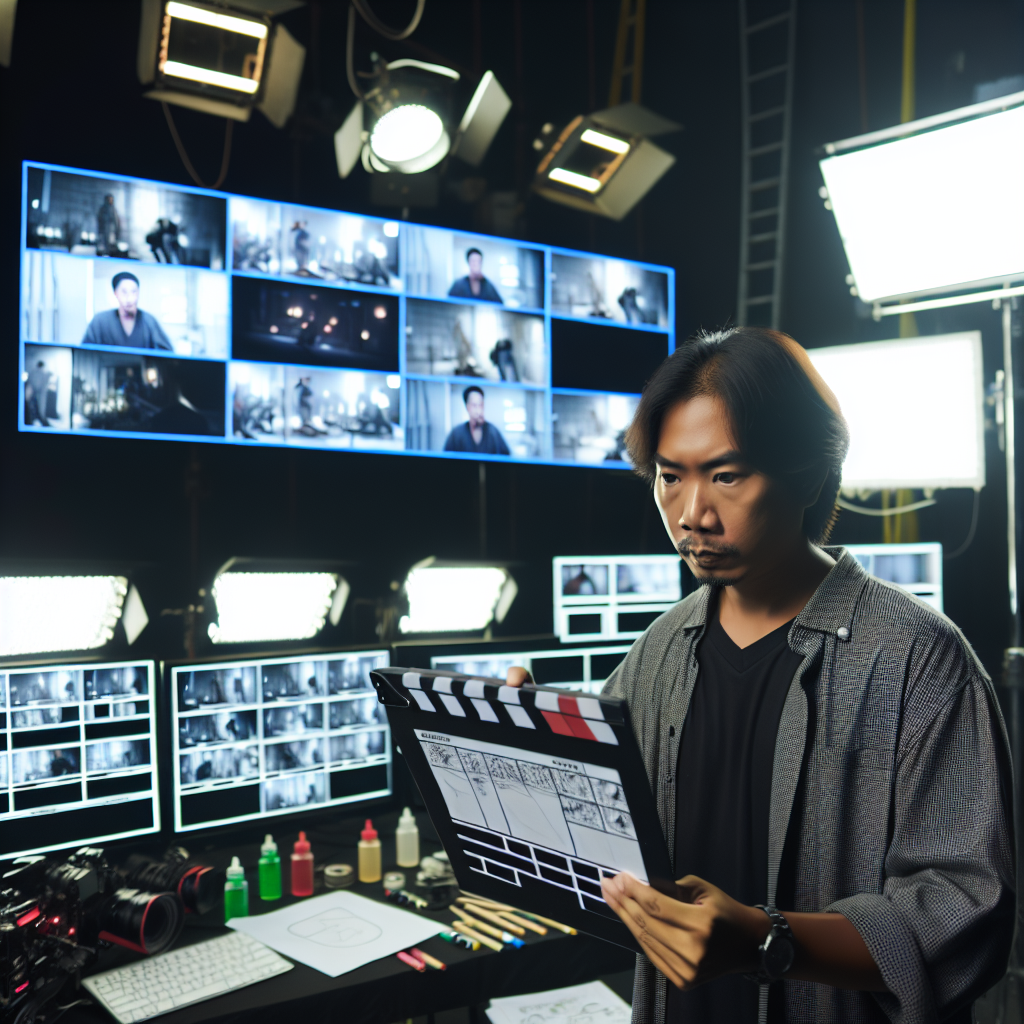Introduction
Creative directors play a crucial role in film and television.
They oversee the artistic vision and execution of projects.
Their influence shapes the entire aesthetic and emotional tone of a production.
Defining the Role of a Creative Director
The creative director is responsible for guiding the visual storytelling of a film or show.
They collaborate with directors, producers, and designers to create a cohesive vision.
This role demands a unique blend of artistic talent and leadership skills.
Creative directors curate the look of sets, costumes, and lighting, ensuring every element aligns with the intended message.
The Importance of Creative Directors
Creative directors significantly impact the overall look and feel of a project.
Their decisions affect how audiences perceive narratives and characters.
A well-executed visual style enhances storytelling, creating memorable experiences.
Creative directors balance innovation and tradition, constantly pushing boundaries while respecting genre conventions.
Their insights transform scripts into immersive visual journeys, captivating viewers.
Effective communication with the crew is essential for maintaining a harmonious workflow.
Successful Creative Directors in the Industry
Numerous creative directors have left indelible marks on film and television.
For instance, Ridley Scott is renowned for his visually stunning films.
He expertly blends imagery with compelling narratives.
Tim Burton brings a whimsical yet dark aesthetic, captivating audiences with his unique style.
Additionally, the work of Jean-Pierre Jeunet, known for “Amélie,” demonstrates creative directors’ power in shaping moods through visuals.
Netflix’s “The Crown,” helmed by director Peter Morgan, showcases the exceptional input of creative aesthetics.
These directors demonstrate how a strong artistic vision influences the success of a project.
Transform Your Career Today
Unlock a personalized career strategy that drives real results. Get tailored advice and a roadmap designed just for you.
Start NowEducation and Background of Creative Directors
Creative directors in film and television often possess diverse educational backgrounds.
Many start with a formal education in fields like film, theater, or fine arts.
Others may hold degrees in communications, graphic design, or literature.
Some creative directors pursue specialized programs.
These programs focus on directing, cinematography, or production design.
Institutions like film schools provide comprehensive training in various aspects of filmmaking.
Internships play a crucial role in this field.
Many aspiring directors gain real-world experience through internships with production companies.
Such exposure helps them understand industry dynamics and build valuable skills.
Workshops and seminars also offer additional training.
These experiences allow creative directors to learn from industry veterans.
Networking opportunities within these programs often lead to beneficial connections.
Paths to Becoming a Creative Director
Becoming a creative director requires perseverance and diverse experiences.
Individuals can follow various paths to achieve this goal.
Here are some common routes:
- Film School: Enrolling in a film school provides essential training and networking opportunities.
- Independent Projects: Many start by creating short films or web series to showcase their talent.
- Assistant Roles: Gaining experience as an assistant director or producer helps build skills and connections.
- Theater Experience: Involvement in theater can enhance storytelling skills and directorial vision.
- Networking Events: Attending festivals and events connects aspiring directors with industry professionals.
Each of these paths offers unique advantages.
Creative directors often blend experiences from various backgrounds.
They draw inspiration from their education and practical experiences.
Showcase Your Business Today
Reach thousands of readers actively exploring professional services. Publish your business profile and grow your audience now.
Publish NowSkills and Qualities Needed to Excel
Creative directors must possess a diverse skill set to succeed.
Here are some essential skills and qualities:
- Vision: A clear artistic vision defines their directing style and influences creative choices.
- Leadership: They must effectively lead diverse teams and inspire others to realize their vision.
- Communication: Strong communication skills facilitate collaboration with writers, actors, and crew.
- Problem-Solving: Creative directors frequently face unexpected challenges that require quick thinking.
- Attention to Detail: Every aspect of production—from script to shot—demands keen attention to detail.
- Adaptability: The film and television landscape is constantly changing; flexibility is vital.
- Knowledge of Technology: Familiarity with filmmaking technology and software enhances their creative processes.
These skills set successful creative directors apart.
They allow them to navigate the complexities of the film and television industry effectively.
The Role of Mentorship and Networking
Mentorship plays a pivotal role in shaping a creative director’s career.
Learning from experienced professionals accelerates growth and provides valuable insights.
Here are some ways mentorship benefits aspiring directors:
- Guidance: Mentors offer guidance on navigating the industry and making impactful career decisions.
- Feedback: Constructive criticism from mentors improves creative work and enhances skills.
- Opportunities: Mentors can provide access to job openings and important industry contacts.
- Confidence: Support from mentors builds confidence, encouraging individuals to pursue ambitious projects.
Networking is equally essential in the film and television industry.
Successful directors actively engage in networking activities.
These can include:
- Industry Events: Film festivals, workshops, and networking events foster connections.
- Professional Organizations: Joining associations can lead to opportunities to collaborate with peers.
- Social Media: Online platforms enable creative directors to showcase their work and connect with industry professionals.
Building a robust professional network opens doors to collaborations and job opportunities.
Networking and mentorship together lay a solid foundation for success in directing.
Collaboration in Film and Television
In the film and television industry, collaboration is paramount.
Creative directors play a crucial role in ensuring that a project meets the artistic vision laid out at the outset.
They work closely with various key players, including directors, producers, cinematographers, and other crew members.
Their combined efforts create a cohesive narrative while ensuring each element aligns with the overall vision.
Understanding Relationships
Creative directors must build strong relationships with other key players in the industry.
They interact continuously with directors to ensure the artistic perspective complements the overall direction of the project.
The director generally focuses on the performance and overall aesthetic, while the creative director zeroes in on the branding and visual identity.
Producers also play a vital role in this dynamic.
Producers manage the logistics and finances, leaving creative directors with the freedom to explore artistic avenues.
This partnership allows creative directors to push boundaries while keeping the project grounded in practicality.
Collaboration Dynamics
The collaboration between creative directors and these key players can influence every stage of production.
Early discussions help define the project’s tone, style, and expectations.
Strong initial communication sets a solid foundation.
For instance, discussing character arcs with directors will yield better visual representations from creative directors.
On the set, creative directors oversee costumes, makeup, and set design.
They must guide these departments to bring their vision to life.
Contentment with the creative direction often leads to better morale among the crew.
When everyone understands the final goal, the creative synergy enhances the entire experience.
Key Collaborators
- Directors: They act as the main visionaries for the entire project. Creative directors transition that vision into a practical aesthetic.
- Producers: They manage budgetary concerns. Their input helps align creative ideas with financial realities.
- Writers: These individuals shape the story. Effective communication with writers ensures artistic consistency throughout the script.
- Cinematographers: They capture the visual storytelling. Creative directors often confer with cinematographers about visual styles and lighting.
- Production Designers: These team members create the physical environments. Collaborative discussions help set the visual tone through sets and props.
- Costume Designers: They help define characters through clothing. Consultation ensures that characters’ visual elements align with the project’s artistic vision.
- Sound Designers: Sound adds emotional layers to visual elements. Working with these experts can elevate a project significantly.
Effective Collaboration Techniques
Establishing effective collaboration fosters a productive working environment.
Here are some essential tips for maintaining healthy working relationships:
- Open Communication: Maintain transparent dialogue between all parties. Ensure everyone feels comfortable sharing ideas and concerns.
- Set Clear Objectives: Define goals at the beginning. Clarity helps keep everyone aligned throughout the process.
- Encourage Feedback: Develop a culture where feedback is welcomed. Constructive criticism can significantly enhance the project.
- Respect Individual Roles: Acknowledge and honor each individual’s contributions. This respect fosters a collaborative spirit.
- Regular Check-ins: Schedule ongoing meetings. Consistent communication can preempt misunderstandings.
- Embrace Flexibility: Be ready to adapt. Changes in the project may necessitate shifts in focus; flexibility is essential.
- Show Appreciation: Recognize the efforts of your team. Expressions of gratitude boost morale and productivity.
The Impact of Collaborative Efforts
The role of the creative director in film and television is multifaceted.
They act as the glue that holds various elements together.
Their close collaboration with other key players leads to well-rounded projects.
Each team member contributes a unique skill set, and only through effective collaboration can the best ideas surface.
Understanding these relationships and embedding effective communication techniques will enhance the outcome of any production.
Creative directors must navigate these dynamics with care, as they shape not only the project but also the experiences of everyone involved.
Collaboration is the heartbeat of creative endeavors.
It nurtures innovative ideas and transforms them into captivating stories.
Showcase Your Business Today
Reach thousands of readers actively exploring professional services. Publish your business profile and grow your audience now.
Publish NowThe synergy between creative directors, directors, producers, and the entire crew is vital to successful storytelling in film and television.
Their collective efforts yield exceptional results that resonate with audiences, making these collaborations not just important but essential for achieving artistic excellence.
See Related Content: How to Use Market Research to Drive Marketing Strategy
Balancing Creative Vision with Budget Constraints
Creative directors in film and television have a demanding role.
They must convey powerful narratives and stunning visuals while adhering to strict budgetary limits.
This balance between creativity and financial reality often poses significant challenges.
Understanding these challenges is essential for aspiring directors and industry professionals alike.
The Challenges Creative Directors Face
Creative directors often face numerous challenges when managing their visions under budget constraints.
Here are the primary issues they encounter:
- Limited Resources: Directors frequently deal with limited funds for production, equipment, and personnel.
- Time Pressure: Tight schedules can hamper innovative concepts and thorough creative exploration.
- Stakeholder Expectations: Directors must balance their creative visions with the expectations of producers and investors.
- Cost Overruns: Unforeseen expenses can quickly arise, threatening the project’s creative integrity.
- Budget Cuts: Last-minute budget cuts can force directors to eliminate key elements from their vision.
Strategies for Managing Finances
To navigate these challenges, creative directors employ various strategies.
These strategies allow them to safeguard their creative integrity while working within budget constraints.
Here are effective methods:
- Prioritize Key Elements: They focus on the most vital aspects of their vision and allocate resources accordingly.
- Collaborate Early: Engaging with producers and financial teams early in the process helps align vision with budget.
- Explore Alternative Funding: Many seek sponsorships or partnerships to supplement limited budgets.
- Use Non-Traditional Locations: Choosing unique filming locations can reduce costs and elevate the narrative.
- Opt for Minimalism: Emphasizing simplicity in set design or effects can still achieve strong visual impact.
- Invest in Pre-Production: Thorough planning reduces unexpected costs during filming, saving both money and time.
Real-Life Examples
Real-life examples illustrate how creative directors successfully navigate tight budgets while achieving their visions.
These cases provide valuable insights for today’s directors:
- Example 1: “The Blair Witch Project”
This groundbreaking horror film was created on a budget of just $60,000. The directors cleverly used handheld cameras and improvisation, making the most of available resources. The film grossed nearly $250 million, showcasing the potential of a strong creative vision. - Example 2: “Moonlight”
This Oscar-winning film had a budget of approximately $1.5 million. Director Barry Jenkins focused on strong character development and realistic performances. He minimized special effects and extravagant set pieces, focusing instead on the story and emotions. - Example 3: “Mad Max: Fury Road”
While this film had a higher budget, director George Miller faced significant challenges early in production. Initially facing budget overruns, he restructured the production schedule and minimized CGI use. The investment in practical effects resulted in a visually stunning and critically acclaimed film. - Example 4: “Garden State”
Zach Braff’s directorial debut had a budget of only $2.5 million. He managed costs by shooting in his hometown and employing local actors. His authentic storytelling contributed to its success, illustrating that creativity can thrive even in restricted environments. - Example 5: “The Florida Project”
This film had a budget of $2 million and focused heavily on location-based storytelling. Director Sean Baker captured the essence of childhood by making the most of the rich environments around him. The film received critical acclaim despite its budget limitations.
Facing Budget Constraints with Ingenuity
Creative directors frequently grapple with the delicate balance between their vision and budget constraints.
By understanding the challenges and applying effective strategies, they can navigate these tight financial landscapes.
Moreover, real-life examples show that resourcefulness and creativity can yield remarkable results.
The stories of these directors not only inspire future filmmakers but also highlight the potency of creativity in the face of adversity.
Explore Further: Educational Pathways for Advertising Account Executives
Trends and Innovations in the Industry
The film and television industry is evolving rapidly.
Creative directors play a crucial role in this transformation.
They embrace new technologies and methodologies to create compelling content.
Here are some of the most significant trends currently shaping the industry:
- Streaming Services Domination: Platforms like Netflix and Amazon Prime are reshaping consumption habits. Viewers expect high-quality, diverse content, pushing creative directors to innovate continually.
- Virtual and Augmented Reality: VR and AR technologies are becoming more prevalent. This shift encourages creative directors to think outside traditional storytelling methods.
- Diversity and Inclusion: Audiences demand representation in storytelling. Creative directors focus on inclusive narratives, ensuring various voices are heard.
- Short-Form Content: With social media platforms, shorter content is growing in popularity. Directors now craft engaging narratives within limited timeframes.
- Sustainable Production: Concerns about environmental impact are growing. Creative directors increasingly emphasize eco-friendly practices in their projects.
Advancements in Technology Impacting Creative Directors
Technology is a double-edged sword in the film and television industry.
It offers immense possibilities while introducing new challenges.
Creative directors must adapt quickly to stay relevant.
Here’s how advancements in technology impact their roles:
- High-Definition and 4K Filming: The demand for visually striking content is increasing. Creative directors use advanced camera systems to enhance visual storytelling.
- Editing Software Innovations: Tools like Adobe Premiere Pro and Final Cut Pro have become more powerful. These programs allow directors to manipulate footage seamlessly, expediting the editing process.
- AI and Machine Learning: Artificial intelligence is changing scriptwriting and editing. It provides insights into audience preferences, guiding creative decisions.
- Remote Collaboration Tools: Platforms like Zoom and Slack facilitate teamwork across distances. Creative directors now manage global teams effectively without geographical constraints.
- Visual Effects (VFX) Advancements: Cutting-edge VFX technologies captivate audiences. Directors leverage these tools to create stunning visual narratives that leave a lasting impact.
Emerging Trends in Film and Television Production
As technology advances, so do production methodologies.
Several emerging trends demand the attention of creative directors:
- Content Personalization: Tailored content is on the rise. Directors are increasingly focusing on analytics to create personalized viewer experiences.
- Interactive Storytelling: Audiences crave engagement. Creative directors experiment with interactive formats that let viewers decide the narrative’s progression.
- Documentary-Style Filmmaking: Authenticity resonates with modern audiences. Creative directors often incorporate documentary elements into fictional narratives to enhance realism.
- Focus on Mental Health: Storylines exploring mental health issues are gaining traction. Directors are addressing this sensitive topic with care and creativity.
- Global Collaboration: Cultural exchanges in storytelling enrich productions. Creative directors increasingly seek diverse international collaborations to broaden narrative perspectives.
How Creative Directors Adapt to Changes
In this ever-evolving landscape, creative directors must adapt proactively.
Here’s how they navigate these trends and innovations:
- Continuous Learning: Creative directors prioritize education.
- Networking: Building connections remains essential. Directors engage with fellow professionals to share ideas and experiences that foster growth.
- Experimentation: Embracing risk drives innovation. Creative directors are willing to experiment with untested concepts and narratives.
- Audience Engagement: Understanding viewer preferences is vital. Directors actively seek feedback through social media and analytics to refine their work.
- Collaboration with Technologists: Working closely with technology experts adds value. Creative directors integrate technical knowledge into storytelling for optimal results.
The film and television landscape is witnessing unprecedented change.
Creative directors are on the front lines of this evolution.
Their ability to adapt drives the industry forward.
They leverage technology, embrace trends, and push boundaries to create artistic, engaging narratives.
As these changes unfold, audiences eagerly anticipate what the future holds.
Advancements in technology significantly impact creative directors in film and television.
They need adaptive strategies to thrive in this dynamic environment.
By embracing innovation and staying connected, creative directors will shape the next generation of storytelling.
These trends influence how stories are told and redefine the very essence of creative direction.
Showcase Your Business Today
Reach thousands of readers actively exploring professional services. Publish your business profile and grow your audience now.
Publish NowFind Out More: Broadcast Technician Job Outlook in the USA

Diversity in Storytelling
Diversity holds immense importance in storytelling.
It enriches narratives and reflects real-world experiences.
Audiences crave authenticity and representation.
When stories depict varied backgrounds, they resonate more deeply.
Creative directors play a crucial role in this.
They can shape the cultural fabric of film and television.
By prioritizing diverse voices, they broaden audience appeal.
This inclusivity nurtures understanding among different communities.
Moreover, stories told from diverse perspectives often lead to innovative approaches.
They challenge stereotypes and dismantle preconceived notions.
Fresh viewpoints can spark conversations and encourage empathy.
Importance of Diverse Decision-Making
Diverse decision-making drives creative excellence.
When teams reflect various identities, they produce more relatable content.
This leads to unique narratives that might otherwise go untold.
Executive producers, writers, and directors must prioritize diversity.
Their choices directly influence on-screen representation.
By including diverse voices, they create a ripple effect across the industry.
Consider the benefits of diverse teams:
- Enhanced creativity and innovation.
- Greater audience engagement and connection.
- Improved problem-solving through varied perspectives.
- Stronger marketability across diverse demographics.
Working with a diverse team fosters an inclusive atmosphere.
This atmosphere encourages open dialogue and collaboration.
Such environments cultivate trust, which leads to more inspired storytelling.
Promoting Inclusivity in Creative Projects
Creative directors command significant influence within the industry.
They navigate the complexities of project development and execution.
By championing inclusivity, they set a standard for their peers.
Here are effective strategies for promoting inclusivity:
- Prioritize diverse casting choices, reflecting authentic communities.
- Incorporate diverse writers, directors, and producers in project teams.
- Engage in community outreach, ensuring underrepresented voices are heard.
- Continuously educate teams on cultural sensitivity and representation.
- Foster mentorship programs that focus on minority talent.
These strategies encourage broader engagement and connection.
They demonstrate the power of representation in creative narratives.
Organizations Promoting Diversity and Representation
Many initiatives and organizations work tirelessly to enhance representation.
Here are some noteworthy examples:
- Women in Film: Focuses on promoting gender equality across all aspects of the film industry.
- Color of Change: Advocates for racial justice and pushes for representation in media.
- National Association of Latino Independent Producers: Strives to promote Latino visibility in the entertainment industry.
- BLACK WOMEN FILM NETWORK: Supports Black women filmmakers and creates opportunities for their narratives.
- Sundance Institute’s Catalyst Program: Mentors underrepresented filmmakers, providing essential resources.
These organizations empower individuals and inspire change.
They address systemic inequities and advocate for a more inclusive landscape.
The Future of Diversity in Film and Television
As the industry evolves, the demand for diversity intensifies.
Audiences expect authentic representation now more than ever.
The power of storytelling lies in its ability to unite people.
Creative directors hold the keys to this change.
By embracing diversity, they can drive the narrative in meaningful ways.
Each project is an opportunity to celebrate different cultures and histories.
Future filmmakers must understand this responsibility.
The stories they tell can shape societal perceptions and attitudes.
Showcase Your Business Today
Reach thousands of readers actively exploring professional services. Publish your business profile and grow your audience now.
Publish NowA commitment to diversity enhances the richness of their narratives.
Let us celebrate all voices in this vibrant tapestry of narratives.
Change is not just necessary; it is essential.
Together, we can foster an industry that reflects and inspires all.
Explore Further: Effective Communication Skills for Media Trainers
Case Studies of Successful Projects Led by Creative Directors
Creative directors in film and television play crucial roles in project development.
Their vision shapes the narrative, aesthetics, and overall tone.
This section highlights specific successful projects.
Each project exemplifies the impact of creative directors.
We will analyze their contributions and extract lessons learned.
“Mad Men” – Matthew Weiner
“Mad Men” revolutionized television storytelling and aesthetics.
Matthew Weiner, as the creative director, meticulously crafted its unique identity.
Weiner’s vision emphasized character development and historical accuracy.
Through rich visuals and complex characters, “Mad Men” drew viewers into the 1960s.
Impact of Weiner’s Creative Vision
- Portrayal of authenticity resonated with audiences.
- Character arcs represented real human emotions and conflicts.
- Stunning cinematography captured the essence of the era.
The show’s layered narratives and intricate dialogue became widely praised.
It won numerous awards, solidifying its status.
Weiner’s commitment to detail and character depth played pivotal roles.
His vision created a cultural phenomenon that engaged viewers.
This case study shows the influence of strong creative direction.
“Black Panther” – Ryan Coogler
“Black Panther” stands as a landmark achievement in superhero cinema.
Ryan Coogler, the creative director, infused African culture into the narrative.
His vision redefined representation in Hollywood.
Coogler’s storytelling highlighted themes of identity, heritage, and social justice.
Impact of Coogler’s Creative Vision
- Rich cultural elements resonated globally, appealing to diverse audiences.
- Strong female characters challenged traditional gender roles.
- The film’s soundtrack and score enhanced its emotional depth.
“Black Panther” became a cultural touchstone, breaking box office records.
Coogler’s innovative approach redefined superhero narratives.
This case study illustrates the potential for creative directors to influence mainstream cinema.
Coogler not only entertained but sparked conversations on critical issues.
“The Handmaid’s Tale” – Bruce Miller
Adapted from Margaret Atwood’s novel, “The Handmaid’s Tale” gained significant acclaim.
Bruce Miller, as the creative director, brought this dystopian world to life.
His vision established a chilling atmosphere and strong emotional resonance.
Miller’s adaptation emphasized societal themes that resonate today.
Impact of Miller’s Creative Vision
- The show sparked discussions on women’s rights and autonomy.
- Visual storytelling evoked a haunting, immersive quality.
- Complex character relationships added depth to the narrative.
The series garnered numerous accolades and a dedicated fan base.
Miller’s commitment to capturing Atwood’s essence proved successful.
This case study showcases the power of adapting literature into visual media.
Miller’s direction provoked critical dialogues and connected with viewers on various levels.
“The Crown” – Peter Morgan
Netflix’s “The Crown” portrays the life of Queen Elizabeth II.
Peter Morgan, the creative director, delicately navigated historical events.
His vision offered an intimate look at royal life.
Morgan focused on character-driven storytelling and rich historical context.
Impact of Morgan’s Creative Vision
- Meticulous attention to historical accuracy engaged viewers.
- Strong performances brought depth to iconic figures.
- The cinematography created a visually stunning narrative.
“The Crown” received critical acclaim, winning numerous awards.
Showcase Your Business Today
Reach thousands of readers actively exploring professional services. Publish your business profile and grow your audience now.
Publish NowMorgan’s vision transformed historical drama into a compelling series.
This case study underscores the importance of creative storytelling in biographical narratives.
Morgan’s approach demonstrated how to blend history with fiction effectively.
“Stranger Things” – The Duffer Brothers
“Stranger Things” revitalized the horror and sci-fi genres.
The Duffer Brothers, as creative directors, crafted a nostalgic yet innovative narrative.
Their vision combined supernatural elements with 1980s pop culture.
This blend captured hearts across generations.
Impact of The Duffer Brothers’ Creative Vision
- Nostalgic references appealed to a wide audience.
- Strong character development drew viewers deeply into the story.
- The soundtrack enhanced the overall viewing experience.
The show became a cultural phenomenon, spawning merchandise and spin-offs.
The Duffer Brothers showcased how nostalgia can drive engagement.
This case study highlights the effectiveness of creative direction in genre storytelling.
Their unique approach created a dedicated fanbase and widespread influence.
Key Takeaways and Lessons Learned
- Visionary Leadership: Strong creative direction can elevate narratives and aesthetics.
- Character-Driven Stories: Depth in characters attracts and retains viewers.
- Cultural Relevance: Engaging with current issues enhances relatability.
- Attention to Detail: Visual and narrative details enrich the overall experience.
- Nostalgia as a Tool: Leveraging nostalgia can broaden audience reach.
These case studies demonstrate how creative directors shape projects.
Their unique perspectives not only drive success but also influence culture.
Understanding their approaches allows aspiring creators to learn valuable lessons.
A strong creative vision leads to impactful storytelling in film and television.
Creative Directors in Film and Television
Creative directors profoundly influence the film and television industry.
They unite vision, artistry, and technical prowess in their projects.
These leaders shape narratives and define visual styles.
Through collaboration, they breathe life into scripts and concepts.
Creative directors not only oversee artistic elements but also facilitate effective communication.
They ensure everyone, from actors to technicians, shares a unified vision.
The Importance of Creativity and Innovation
Creativity drives the film and television industry forward.
As trends evolve, creative directors must adapt and reinvent their approaches.
Innovation is crucial in storytelling and production techniques.
Successful projects often emerge from boundary-pushing ideas and unconventional methods.
Ultimately, creative directors challenge the status quo to engage audiences.
Encouragement for Aspiring Creative Directors
To aspiring creative directors, pursue your passion relentlessly.
Embrace your unique voice and perspective in storytelling.
Remember, every great director started as a novice with dreams.
Learn from experiences and allow those lessons to shape your craft.
Seek collaboration and inspiration from diverse sources.
Your vision can make a significant impact on the industry.
Believe in your potential to redefine narratives and styles.
With determination and creativity, you can create something truly memorable.
Additional Resources
Radio/Television/Film: School of Communication – Northwestern …
RTF – Radio-Television-Film < The University of Texas at Austin
[E-Books for Sale]
The Big Book of 500 High-Paying Jobs in America: Unlock Your Earning Potential
$19.99 • 500 High-Paying Jobs • 330 pages
Explore 500 high-paying jobs in America and learn how to boost your career, earn more, and achieve success!
See All 500 High-Paying Jobs of this E-Book
1001 Professions Without a Degree: High-Paying American Jobs You Can Start Now
$19.99 • 1001 Professions Without a Degree • 174 pages
Discover 1001 high-paying jobs without a degree! Unlock career tips, skills, and success strategies for just $19.99!




